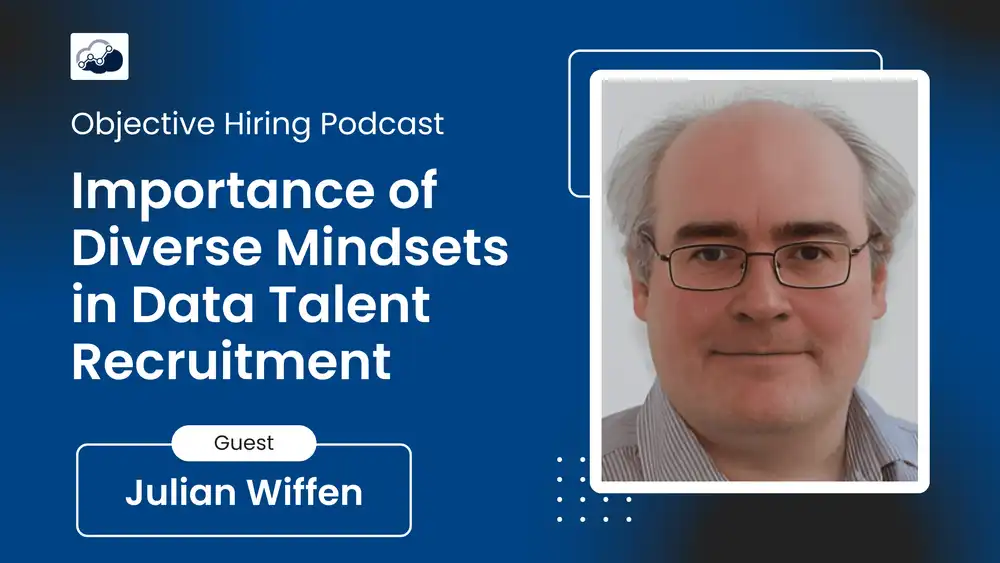Julian Wiffen on How AI is Reshaping Recruitment—from CV Screening to Fairer Hiring

In this episode of the Objective Hiring podcast, Julian Wiffen, Chief of AI & Data Science at Matillion, shares with Tim Freestone, founder of Alooba, how artificial intelligence is reshaping the hiring process—from screening CVs to providing structured candidate feedback.
Automating CV review with yes/no criteria
Julian outlines Matillion’s experiments with embedding generative AI tools directly into recruitment workflows. Rather than evaluating CVs based on vague, subjective impressions, they are using AI to answer simple, auditable questions:
“Does this CV show any experience in Python? More than the most basic experience?”
By turning gut feel into yes/no logic, the process becomes more consistent and transparent. These flags are used to assess qualifications against predefined job criteria. It’s not about removing humans from the process—but about giving them clearer tools to make better decisions.
“We’re not building something to replicate human bias—we’re building something more structured, more fair.”
Feedback loops for rejected candidates
AI is also enabling a novel concept: giving rejected candidates useful, personalised feedback—at scale. A model can summarise what a CV shows evidence of, and also what’s missing. Candidates can then respond or highlight additional experience.
“That kind of feedback loop would be impossible for a recruiter to do manually—but automation makes it realistic.”
This approach helps shift recruitment from a single-use, black-box system into a continuous dialogue. In turn, companies can encourage reskilling and even rediscover candidates for future roles.
A more flexible CV format
The use of AI also challenges the long-standing assumptions around CV structure. When documents are being read by machines—not rushed humans—length and format become less critical.
“You’re no longer limited by someone’s five seconds of attention. Send a long CV, links, videos, GitHub—it can all be processed.”
Julian predicts a shift towards ‘portfolio hiring,’ where candidates present evidence from across formats and media. And as AI tools mature, they can synthesise this variety into digestible summaries for decision-makers.
This aligns with Alooba’s mission: helping employers move beyond CVs and evaluate people for their real skills. Sign up here to see how skills-based assessments can support fairer hiring.
Rethinking recruiter intuition
Tim shares an experiment Alooba ran: they gave the same set of CVs and a job description to 10 recruiters. Despite the identical inputs, almost all had different shortlists. The takeaway?
“There was only one candidate more than three of the ten selected. The randomness was staggering.”
Julian agrees, suggesting that recruiters are often filling in the gaps with their own mental models. AI can help counterbalance that—especially by surfacing candidates who might otherwise be overlooked.
“It’s the difference between replicating human bias and scaling a structured process.”
Training AI on flawed data
A major risk with AI-based hiring tools is training them on biased data sets. If a model is trained on the past decisions of human recruiters, it may simply perpetuate existing inequalities.
Julian’s solution? Use AI to augment—not replace—recruiter judgment. Track where the model and human disagree. Use these gaps as learning opportunities.
“There’s rich insight in comparing the CVs humans rejected that the model liked—and vice versa.”
This feedback loop builds trust in the system and allows for continuous refinement before deploying AI in higher-stakes screening contexts.
From one-time filters to ongoing rediscovery
Another key shift AI enables is persistent talent matching. Rather than a static ‘no,’ AI can flag future-fit candidates for other roles when they emerge.
“Rescreening becomes a much lower-intensity task. You could easily notify someone: ‘You weren’t right for this, but we’ve found a better fit.’”
This also removes pressure for CVs to be perfectly tailored. With automated summarisation, candidates can include broader information without worrying about overloading the reader.
Making hiring fairer—with data
Julian’s data-led mindset also helped Matillion address diversity challenges in recruitment. At a previous employer, he tackled gender imbalance in software engineering hires. The data showed every stage of the process was fair—but women weren’t applying in the first place.
“We changed the wording. We said: ‘We’re looking for people willing to learn these skills.’ That one shift took us from 10% to 40% female applicants.”
This simple change had huge effects—bringing in more applicants from all backgrounds and increasing the average quality across the board.
“It didn’t cost anything except being willing to look at the data. That’s why I always share this story.”
This story reinforces a core principle of Alooba: hiring should be based on objective data, not guesswork.
Can we finally move beyond the CV?
The CV is a legacy tool, built for an era when one person had to scan every candidate manually. Julian believes the future lies in more dynamic, inclusive formats—backed by systems that can process unstructured evidence quickly and fairly.
“Ask candidates to send a video, send their GitHub, send whatever they’ve got—and let the machine pull it all together.”
This kind of content-driven recruitment levels the playing field and allows candidates to be evaluated more holistically.
Final thoughts
Generative AI offers huge promise—but it must be handled responsibly. Julian’s approach shows how combining structured models, human oversight, and a willingness to challenge assumptions can lead to hiring that’s not only faster, but fairer.
To start improving your own hiring decisions with structured skills data, try Alooba. Evaluate what matters—skills, not CV styling.